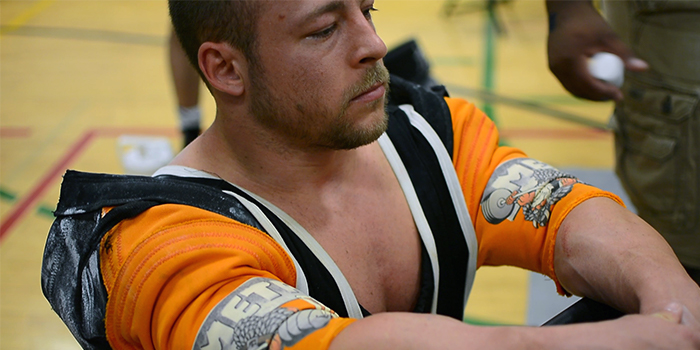
For competitive powerlifters, injuries are inevitable. They mark a point at a crossroads. Some choose to focus on recovery with the goal of coming back stronger. Others become swallowed up by their self-pity and pain and never return to the platform the same.
For Brandon Smitley, it meant making the decision to focus on the lift he could perform without pain — bench. In December 2016, he injured his lower back during an accident squatting with a cambered bar. At the time, he had just come off of the best powerlifting meet of his life, and was training to compete in a bodybuilding show later that spring in order to stay healthy and still chase competitive goals.
Brandon knew that with proper rehab and taking time off, the injury was not a major setback. He stepped down from the bodybuilding show and set his sights on healing his back and being a healthy athlete.
RELATED: Coming to Grips with My Low Back Situations
Here is a rundown of his recovery and rehab schedule:
- 0-2 weeks post-injury: No training and only chiropractic care
- 2-6 weeks post-injury: PRI (Postural Restoration Institute) drills and tissue work. Started training again, lightly, but with no spinal loading.
- 6-16 weeks post-injury: Back at square one with a bar, and slowly built up to about 75-80%. Emphasized bracing and corrective exercises.
- Now: ART (active release technique) and chiropractic care
In May 2015, Brandon competed equipped bench-only at the RPS Lexen Spring Fling and benched 450 in the 148-pound weight class. After his injury, he knew his training recovery would not be going to squat or deadlift, so he came up with a new competitive goal — take the all-time equipped bench record at 132 pounds, his usual competitive weight class.
For his meet prep program for the APF Chicago Summer Bash, Brandon trained 5-7 days per week for a 12-week cycle. He followed a concurrent system with conjugation and was in the Metal Jack bench shirt once every two to three weeks. He combined dynamic effort work and 5/3/1 for his maintenance lower body work in order to focus on bench.
Unfortunately, for this raw lifter, the record wasn’t in the cards that day. After confusion about the timing of the two platforms and a rushed warm-up, he was not able to pull off the meet he needed to take an attempt at the world record.
1st Attempt- 451 Pounds, MISS
Brandon’s arms came up unevenly and the bar started to drift towards his face. After this attempt, he changed his set-up position on the bench, lowered the rack height, and got ready to take another shot at 451 pounds.
2nd Attempt- 451 Pounds, GOOD
He adjusted his shirt and successfully benched 451 pounds. Then, he consulted his handlers, Trey and Alex, and fellow elitefts teammate JP Carroll in order to determine the next attempt. If he could get his third attempt, he would be allowed a fourth for a world record. They decided to split the difference and start chipping away at a 500-pound bench press.
3rd Attempt- 479 Pounds, MISS
He faced the same issue that affected his opener. His right arm lagged behind his left, which is typically not an issue that he faces with his raw bench press.
According to Brandon, part of the problem was that he was not familiar enough with the shirt. “I'm going to continue to work on setting my bench shirt and learning the tricks to that. I feel my biggest weakness is knowing the shirt,” Brandon said. Since he has been in the shirt only about 20 times, he was still dialing in his set-up during the meet.
Overall, Brandon isn’t disappointed with his meet performance. “While I certainly didn't perform up to my standard, I got a PR, a top 10 all-time ranking, and came away injury free,” Brandon said. He believes that equipped benching has strengthened his raw bench and magnified his weaknesses. He plans on applying the lessons learned from his second equipped meet and taking another run at the 132-pound all-time equipped bench record soon.









